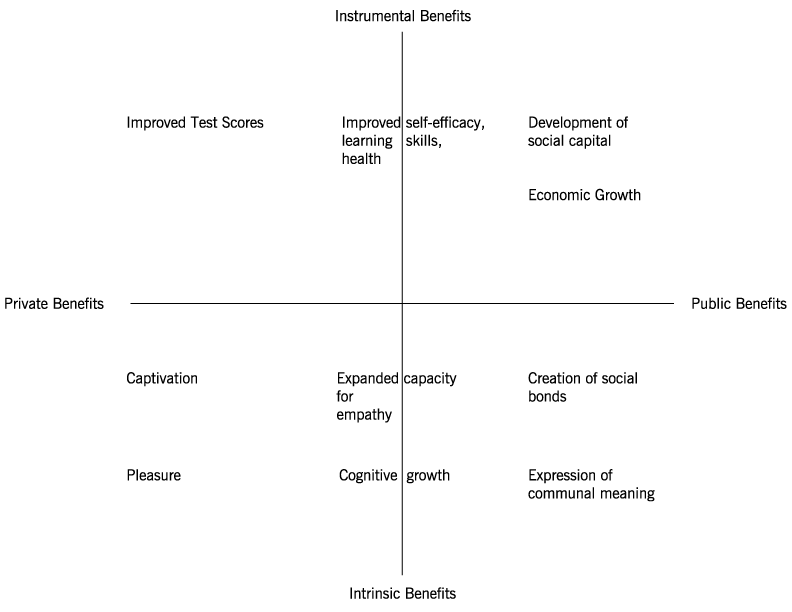How to Show That Your Arts Organization is Critical
Posted by Zach Hochstadt on February 3rd, 2014
Posted in Blog, Email Campaigns, Nonprofit Branding, Nonprofit Communications, Nonprofit Copywriting, Nonprofit Fundraising, Nonprofit Messaging, Performing Arts Tags: branding, communications, development, fundraising, key messages, marketing, messaging, nonprofit, Nonprofit Communications, Nonprofit Copywriting, Nonprofit Fundraising, Nonprofit Messaging, writing
If you’re responsible for raising money for an arts organization, you know this challenge: your donor appreciates your mission and values what you do, but can’t rationalize making a gift when there are others who “need it more.”
So how do you frame your arts organization as critical when other needs are competing for donor dollars?
A widely heralded 2004 study, authored by the Rand Corporation in conjunction with the Wallace Foundation, entitled Gifts of the Muse: Reframing the Debate About the Benefits of the Arts, highlighted several arguments that illustrate your value to the community. Despite being 10 years old, the study should be required reading for any development professional working in the arts.
One of our fundamental beliefs at Mission Minded is that statements about your organization need to be linked back to benefits. It’s not enough to state, “We offer 4 classes per week.” Instead, you should explain, “By offering 4 classes per week, we give students more opportunities to access the arts, which expands their capacity for empathy, cognitive growth, and ultimately, the opportunity to be better citizens.”
Benefits are at the heart of great communications, and the Gifts of the Muse study establishes a framework for communicating the benefits provided by the arts. The arts benefit us as individuals and as a community, offering both intrinsic benefits as well as instrumental benefits. The graph below shows this framework.
We see four major quadrants for arts-based benefits:
Personal-Intrinsic
These are the benefits that the arts bring to us individually. The arts inspire us and give us pleasure. They give us thrilling, uplifting, emotionally-moving experiences. Because of the arts, we become better people. We understand better the plight of others. We empathize, and we grow in our intellectual capacity.
Public-Intrinsic
These are the benefits that make our communities nicer places to live. The arts give us a sense of place and community pride. We know each other better, and therefore feel more connected to one another.
Private-Instrumental
On a personal level, experience with the arts translates into improved learning skills, test scores, and better health. We grow in self-confidence and self-efficacy, meaning we have a greater perceived ability to accomplish a variety of tasks.
Public-Instrumental
The community that invests in the arts benefits from greater economic growth and the development of social capital. The arts don’t just make better individuals, they give communities a competitive edge against other cities, attracting new businesses, inspiring innovation, and a higher functioning society.
Yes, But How Does That Measure Up Against Urgent Needs?
First, it’s essential that you don’t pit one against another. Philanthropy is not a zero sum game. Acknowledge that it’s critical that we help those in crisis.
Second, move to high-level public instrumental benefits. State that while it’s important to take care of those in need, it is an equally urgent need that we make deeper investments in our community to sustain ourselves in the future.
Yes. And.
YES, we need to support those in need.
AND, we need to build and sustain a community that inspires innovation, fosters social cohesion, motivates young learners, and attracts new businesses. Investment in the arts builds an economy and a society better positioned to serve those in need in the future.
Fundamentally, the rationale for supporting the arts is akin to saying that it’s better to teach a man to fish than it is to give a man a fish.
Putting It All Together
At Mission Minded, we believe there are three elements to the formula for making a strong case for your organization:
Urgency + Emotion + Rationale = A Great Case
In other words, as a donor, I must sense that there’s an immediate, active need to participate in or support your arts organization. Your nonprofit speaks to me from the heart, and then gives me the reasons why I can believe it, or rationalize writing a check.
Urgency
Ask yourself “Why is this urgent? If we don’t do this now what will happen?” Ask yourself this question 10 times, allowing each answer to be different. Eventually, you’ll identify the real reason your work is urgently needed.
Emotion
Think about your donor. Imagine she’s a real person. (In fact, here are two helpful posts that tell you how to do this: 10 Questions That Produce Better Psychographic Profiles and Using Personas for Better Communications.) What drives her? What does she care about? How does your work make her feel? That feeling should be at the core of your appeal.
Rationale
Oftentimes organizations want to explain HOW they do their work, but the more important questions to answer is WHY. By asking yourself “Why?” you unlock the rationale. You help your donor understand why she personally should care.
Have you put this into practice at your organization? We want to hear about it.
Zach Hochstadt is a Mission Minded Founding Partner and runs Mission Minded’s Denver office, leading the company’s creative teams in the areas of message development, writing, graphic design, and web design and development.
See all posts by Zach Hochstadt

That formula, Urgency + Emotion + Rationale = A great case, is perfect. I will definitely be thinking of that when I’m writing for a cause(whether for donations or volunteers). Great article!
Thanks, Kristen! Glad you found it useful.